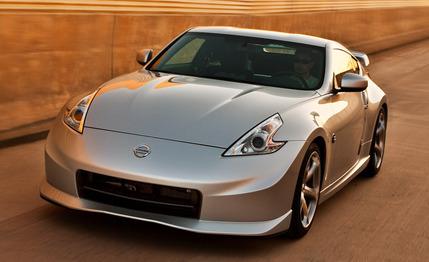
 Short Take Road Test
Short Take Road Test
Sushi chefs know that when preparing blowfish, or fugu, there’s a fine line between paralyzing your patrons and giving them the desired tingly sensation that comes from ingesting a tiny bit of the fish’s deadly poison. Making a great car better needs a similar level of finesse. Nissan’s performance division, NISMO, has attempted to do just that with the 370Z. The question is, has it given the Z car extra pizazz, or has it gone too far?
Flashier Duds, Reflashed Engine
The car clearly looks different, being 7.2 inches longer than the base Z. About six of those seven inches reside in a new nose; the remaining inch and change is in the redesigned rear bumper that comes complete with diffuser. Put the NISMO side by side with a standard Z, and the Adrian Brody schnoz certainly stands out. The redesigned rocker panels make the Z look as though it might be wider, but that’s just a visual trick; it’s the same width. Shorter springs lower the NISMO by 0.1 inch. A larger wing that does a thorough job of blocking rearward visibility resides on the rear hatch. The wing might look import tuner-y, but Nissan claims all the body modifications create no additional drag and generate 18 pounds of downforce over the front axle and 35 pounds over the rear at 75 mph.
Underhood, there’s a similar VQ37VHR V-6 that powers the regular Z, but an ECU reflash and a specially tuned, larger-diameter dual exhaust increase the power to 350 at 7400 rpm. That’s 18 more horses than the standard Z gets, delivered 400 revs higher. Torque is up by 6 lb-ft to 276.
Unfortunately, our test car wasn’t properly broken in when we had the opportunity to run the numbers on it. The performance was good—0-to-60 mph in 5.2 seconds and 13.7 seconds through the quarter-mile at 105 mph—but worse than we have seen in the new 370Z. Those figures certainly didn’t reflect an 18-hp gain. It has been our experience that the VQ-series engines perform better as they age (insert your own cougar joke here), and we feel that the NISMO, after a lengthy break-in period, will match or better 0 to 60 in 4.8 seconds and 13.4 seconds for the quarter, our best times so far for a 370Z.
Fancier Suspenders than Larry King’s
The shorter springs barely scratch the surface of the chassis tweaks Nissan has made. The spring rates and the anti-roll bars are stiffer. The front shocks are 40 percent firmer and the rears are a whopping 140 percent harder. Nissan says the 370Z’s structure is rigid enough and required no additional supports or bracing to cope with the beefed-up suspension, but something needed to be done about the vibrations felt by the occupants. To remedy this, Nissan fitted two dampers designed to absorb body shimmies and shakes. One is mounted in front and is visible through the grille opening, and the one at the back is tucked beneath the spaghetti weave of suspension components.
These changes must work because the NISMO didn’t feel choppy, simply firm. Although the ride is rock solid, it’s not a teeth-jarring race car for the street—as long as the road is baby-bottom smooth. Over bumps and light washboard, the suspension compresses and then rebounds with commanding authority, halting the sinusoidal motion without bouncing the whole car, like, say, a Lexus IS F does. Such a setup means the NISMO is an uncomfortable cross-country GT, but when the road starts turning and twisting, the NISMO is right at home. The steering wheel is heavy in the hands, but it transmits what the Yokohama ADVAN Sport tires—mounted on forged aluminum 19-inch wheels—are doing with German precision. Linking corners together becomes a game the Z is pretty good at, thanks to SynchroRev Match, Nissan’s automated rev matching on downshifts, which erases the need to heel-and-toe. SynchroRev Match combines the best part of a manual—the tactile motion of shifting gears—and the best part of an automated manual—perfectly orchestrated downshifts.
Pricey, but Worth It for Track Rats
On a 200-foot skidpad, the NISMO averaged 0.99 g. That betters the stock Z by a 10th and is most likely attributable to those Yokohama tires. The 70-to-0-mph braking performance of 161 feet is not the best we’ve seen from a new Z and could be blamed on a dusty desert test location. The distance doesn’t tell the whole story, though. All five of our stops were within eight feet of one another, indicating that fade won’t be an issue. Pedal feel is good, too, and modulating it for trail-brake rotation is easy.
The potential for Spaceball One ludicrous speed in this car is so great that the NISMO can’t be fully wrung out on public roads. That’s probably why Nissan targeted the NISMO at “car crazed” customers and expects it to end up in collections or in the hands of track-day enthusiasts. If you are planning on tracking a NISMO or any other 370Z, Nissan recommends a dealer-installed oil cooler because if the oil temperature hits 280 degrees Fahrenheit, the computer limits revs to 5900. They’re further restricted to 4400 rpm if the temperature hits 290 degrees. Our test car was fitted with the cooler, which costs $780 on top of the $39,850 base price. There are no options, save some floor mats and other cosmetic add-ons. So the NISMO’s price seems expensive compared with that of a stock Z, but if you spend all (or even most) of your time lapping tracks, it’s money well spent.